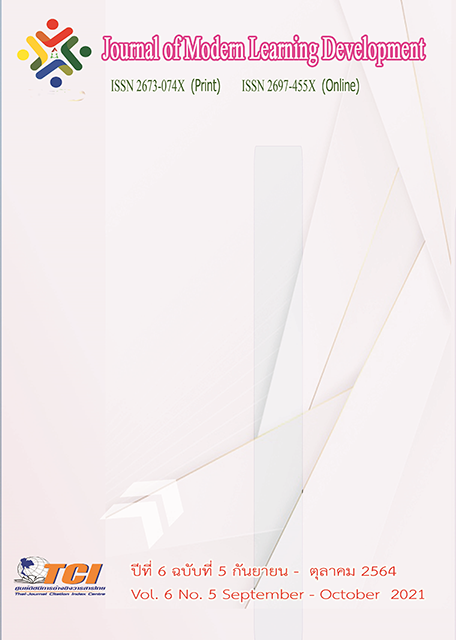The Study of Learning Achievement in Learning English Vocabulary by Using a Picture Word Inductive Model for Prathomsuksa 3 Students
Main Article Content
Abstract
The objectives of this study were to 1) compare learning achievement by using picture word inductive model for Prathomsuksa 3 students before and after learning, 2) to study the behavior of Prathomsuksa 3 students in learning by using picture word inductive model, 3) to examine the satisfaction of Prathomsuksa 3 students towards learning by using picture inductive model. The participants of this study were 29 Prathomsuksa 3 students who studied at Ban Nong Sano school in 2nd semester, academic year 2019. The instruments used in this study were 1) Picture Word Chart, 2) lesson plans, 3) vocabulary learning achievement test, 4) students’ behavior observation form, 5) satisfaction towards learning by using picture word inductive model evaluation form. The statistics used in this study was mean, standard deviation, and dependent t-test.
The results revealed that:
1. The learning achievement in learning English vocabulary for Prathomsuksa 3 students before and after by using Picture Word Inductive Model was higher than before learning with statistical significance at the .05 level. 2. Behavior of Prathomsuksa 3 students in learning by using Picture Word Inductive Model were enthusiastic and assertive when seeing the pictures. They had a good cooperation in doing activities. Moreover, the students were able to pronounce and spell the words correctly when seeing pictures. They can link picture with word. They also can write and construct short sentence. They always reviewed the sentence and vocabulary using picture word cart. 3.Student’s satisfaction towards learning by using picture word inductive model was considered at high level.
Article Details
References
ทิศนา แขมมณี. (2554). ศาสตร์การสอน : องค์ความรู้เพื่อการจัดกระบวนการเรียนรู้ที่มีประสิทธิภาพ. กรุงเทพมหานคร: สำนักพิมพ์จุฬาลงกรณ์มหาวิทยาลัย.
ธูปทอง กว้างสวาสดิ์. (2559) กิจกรรมการเรียนการสอนภาษาอังกฤษ. (พิมพ์ครั้งที่ 2). กรุงเทพมหานคร: สำนักพิมพ์จุฬาลงกรณ์มหาวิทยาลัย.
ธารีรัตน์ อรุณศรี. (2561). การพัฒนาแบบฝึกทักษะการอ่านและการเขียนคำศัพท์ภาษาอังกฤษ โดยใช้รูปแบบการสอนแบบอุปนัยโดยใช้ภาพ- คำ (PWIM) เรื่อง Learning English Vocabulary is fun and easy สำหรับนักเรียนชั้นประถมศึกษาปีที่ 2. ออนไลน์. สืบค้นเมื่อ 9 สิงหาคม 2561. แหล่งที่มา: http://www.utdone.net/polngarn/tareerat/tareerata.html.
ปัญจลักษณ์ ถวาย. (2556). การศึกษาผลสัมฤทธิ์และความคงทนในการจำคำศัพท์ภาษาอังกฤษของนักเรียนชั้นประถมศึกษาปีที่ 5 โรงเรียนประถมสาธิตมหาวิทยาลัยราชภัฏบ้านสมเด็จเจ้าพระยาที่เรียนโดยใช้แบบฝึกกิจกรรมเพิ่มพูนคำศัพท์ร่วมกับการอ่าน. วิทยานิพนธ์ศึกษาศาสตรมหาบัณฑิต สาขาวิชาการสอนภาษาอังกฤษในฐานะภาษาต่างประเทศ. บัณฑิตวิทยาลัย: มหาวิทยาลัยศิลปากร.
ปารณีย์ ไชยรา. (2553). ผลสัมฤทธิ์ด้านการเขียนคำศัพท์ภาษาอังกฤษของนักเรียนชั้นประถมศึกษาปีที่ 6 โรงเรียนมหาไถ่ศึกษาขอนแก่น โดยใช้แบบฝึกเสริมทักษะการเขียนคำศัพท์ภาษาอังกฤษ. วิทยานิพนธ์ศึกษาศาสตรมหาบัณฑิต สาขาวิชาหลักสูตรและการสอน. บัณฑิตวิทยาลัย: มหาวิทยาลัยขอนแก่น.
มนัชยา ศรีจินดา และคณะ. (2555). รายงานผลการวิจัยเรื่อง การพัฒนากิจกรรมการเรียนรู้ กลุ่มสาระการเรียนรู้ภาษาไทย เรื่องรักพ่อ รักแม่ ตามวิธีการเรียนรู้ของ Picture Word Inductive Model (PWIM) โดยใช้กระบวนการศึกษาชั้นเรียน. ขอนแก่น: โรงเรียนสาธิตมหาวิทยาลัยขอนแก่น ฝ่ายประถมศึกษา (ศึกษาศาสตร์).
วัชรา เล่าเรียนดี. (2555). รูปแบบและกลยุทธ์การจัดการเรียนรู้เพื่อพัฒนาทักษะการคิด (พิมพ์ครั้งที่ 9). นครปฐม: คณะศึกษาศาสตร์ มหาวิทยาลัยศิลปากร วิทยาเขตพระราชวังสนามจันทร์
ศิริวรรณ ร่มเย็น วูลเทอร์ และคณะ (2557). การจัดกิจกรรมเพื่อพัฒนาทักษะการเขียนภาษาอังกฤษ สำหรับนักเรียนชั้นประถมศึกษาปีที่ 6 โรงเรียนสาธิตมหาวิทยาลัยขอนแก่น ฝ่ายประถมศึกษา (ศึกษาศาสตร์) โดยใช้แผนการจัดกิจกรรมด้วยรูปแบบ Picture Word Inductive Model. กรุงเทพมหานคร: มหาวิทยาลัยเกษตรศาสตร์.
สุมิตรา อังวัฒนกุล. (2537). กิจกรรมการสอนภาษาอังกฤษเพื่อการสื่อสาร. กรุงเทพมหานคร: จุฬาลงกรณ์ มหาวิทยาลัย.
สุรีพรรณ ฉันวิจิตร. (2557). การพัฒนาทักษะการเขียนคำศัพท์ภาษาอังกฤษ สำหรับนักเรียนชั้นประถมศึกษาปีที่ 6 โดยใช้วิธีการสอนแบบ PWIM (Picture Word Inductive model). ออนไลน์. สืบค้นเมื่อ 9 สิงหาคม 2561. แหล่งที่มา: http://www.t3samakkee.ac.th/news-detail__12553
อมตา เวชพฤติ และคณะ. (2546). How to teach Vocabulary วิธีการสอนศัพท์. กรุงเทพมหานคร: เพียร์สันเอ็ดดูเคชั่น อินโซน่า.
อิศเรศ พิพัฒน์มงคลพร และวิไล พิพัฒน์มงคลพร. (2558). การจัดกิจกรรมการเรียนการสอนแบบพิคเจอร์-เวิร์ด Picture Word Inductive Model. วารสารศึกษาศาสตร์ มหาวิทยาลัยศิลปากร. 13 (1), 17-22.
อรรชนิดา หวานคง. (2559). การจัดการเรียนการสอนภาษาอังกฤษในศตวรรษที่ 21. วารสารสถาบันวิจัยญาณสังวร มหาวิทยาลัยมกุฏราชวิทยาลัย. 7 (2), 303-314
Bromley, K. (2007). Nine Things Every Teacher Should Know About Words and Vocabulary Instruction. Online. Retrieved 9 August 2017. From: https://ila.onlinelibrary.wiley. com/ doi/abs/10.1598/JAAL.50.7.2
Harmer, J. (1991). The practice of English language teaching. Longman Handbooks for Language Teachers. Fourth Edition. Harlow. England: Pearson Longman,
Linse, C. & Nunan, D. (2005). Practical English language teaching: young learners. New York: McGraw-Hill ESL/ELT.


